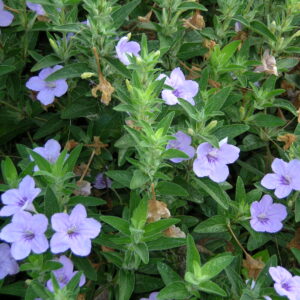Plants for Butterflies and Other Pollinators
Showing 161–168 of 223 results
-
Rudbeckia triloba Branched coneflower, Brown eyed susan Z 3-9
Multitudes of small sunny daisies with brown centers from July to October, as cheery as they come.
Multitudes of small sunny daisies with brown centers from July to October, as cheery as they come.
Size: 3-4' x 2-3'
Care: sun to part shade in moist well-drained soil.
Native: most of North America, Wisconsin native
Wildlife Value: Numerous bees, some flies, a few wasps and butterflies feed on the nectar and pollen. One bee feeds only on Rudbeckias and Ratibida flowers.
Awards: Georgia Gold Medal winner. England’s Royal Horticultural Society Award of Garden Merit.Rudbeckia was named by Linnaeus for his University of Upsala professor and founder of the Uppsala botanic Garden, and his son, University of Uppsala professor named Olaf Rudbeck. This species collected in Colonial Virginia in 1600’s.
-
Ruellia humilis Prairie petunia Z 3-9
Lilac open-face trumpets late June-October. Slow to emerge in spring so be patient and watch for it. It’s one of those non-flashy work-horses. One of internationally known garden designer Piet Oudolf’s 100 “MUST HAVE” plants, Gardens Illustrated 94 (2013)
Lilac open-face trumpets late June-October. Slow to emerge in spring so be patient and watch for it. It’s one of those non-flashy work-horses. One of internationally known garden designer Piet Oudolf’s 100 “MUST HAVE” plants, Gardens Illustrated 94 (2013)
Size: 10-12” x 10”
Care: sun in any soil
Native: Midwest south to Florida and Texas, Wisconsin endangered plant.
Wildlife Value: Pollinated primarily by long tongue bees who can reach far into the flower’s throat.Ruellia named for French royal herbalist Jean Ruell (1474-1537.) First collected by Thomas Nuttall (1786-1859) C.1810 English plant hunter who found more American plants than anyone else, early 1800’s.
-
Salvia amplexicaulis Stem-clasping sage Z 4-8
Erect spikes of two-lipped, purple flowers with reddish-purple bracts in summer. Leaves are fragrant.
Erect spikes of two-lipped, purple flowers with reddish-purple bracts in summer. Leaves are fragrant.
Size: 48" x 36"
Care: Sun to part shade in moist well-drained soil. Deadhead for rebloom.
Native: Southeastern Europe
Wildlife Value: attracts butterflies, deer resistant.Salvia is from the Latin “salveo” meaning “to heal” referring to the plants ancient medicinal uses. This species collected before 1791.
-
Salvia azurea ‘Grandiflora’ Blue sage, Prairie sage Z 5-9
August – October sky blue racemes. One of internationally known garden designer Piet Oudolf’s 100 “MUST HAVE” plants, Gardens Illustrated 94 (2013)
August – October sky blue racemes. One of internationally known garden designer Piet Oudolf’s 100 “MUST HAVE” plants, Gardens Illustrated 94 (2013)
Size: 4’ x 24-36”
Care: Sun, moist well-drained soil
Native: MI to e. NE, s. AR & TX, Wisconsin native
Wildlife Value: Primarily long tongued bees such as Bumble bees visit and pollinate the plants. Host for caterpillars of Hermit Sphinx butterflyNative Americans roast or popped the seed of Blue sage as a grain. American garden cultivation since 1700’s. William Robinson, father of the mixed perennial border, praised the Blue sage as “one of the finest (perennials from North America) in its flowers, borne as dense spikes of a beautiful pale blue during September and October.”
-
Salvia nemorosa Meadow sage, Balkan clary Z 5-7
Purple/lavender spire dense with flowers June to September
Dense purple spires flower June to September (if cutback after 1st flush of flowers).
Size: 36" x 24"
Care: full sun in moist well-drained to well-drained soil. Drought tolerant.
Native: Europe to Central Asia.
Wildlife Value: attracts butterflies & hummingbirdsSalvia is from the Latin word salveo meaning “to heal” referring to the plant’s ancient medicinal uses. Collected before 1753.
-
Salvia nutans Nodding sage Z 5-8
Nodding clumps of sky blue flowers high over basal leaves, flower in late spring-early summer.
Nodding clumps of sky-blue flowers high over basal leaves, flower in late spring-early summer.
Size: 3-4’ x 18”
Care: sun to part shade in moist, well-drained soil.
Native: Balkans
Wildlife Value: attracts bees & butterflies seeking pollen and nectar. Deer resistant.Collected before 1753. Introduced to gardens in 1780 by Peter Simon Pallas (1741-1811) Berlin botanist who collected extensively in Russia. Grown in nursery of Joseph Knight, King’s Road, London. Pictured in Curtis’s Botanical Magazine Vol. 50, 1822.
-
Salvia sclarea Clary sage Reseeding Biennial Z 5-9
Extraordinary pastel panicles of cream, blue or pink, bi-toned bracts whorl around the stem spring – summer
Extraordinary pastel panicles of cream, blue or pink, bi-toned bracts whorl around the stem spring – summer
Can not ship to: Washington
Size: 3’ x 12”
Care: full sun in moist well-drained soil.
Native: Europe to Central Asia
Wildlife Value: attracts hummingbirds and butterflies. Deer resistant.Salvia is from the Latin salveo meaning “to heal” referring to the plant’s ancient medicinal uses. This species introduced to gardens from the south of Europe in 1562.
-
Salvia verticillata Lilac sage, whorley clary, Salbey Z 5-8
Muted lilac blue spikes June to October
Muted lilac blue spikes June to October, deadhead for more blooms.
Size: 24” x 18-24”
Care: sun in moist well-drained to well-drained soil. Cut back after first bloom to repeat.
Native: Spain to Ukraine, Caucasus to Iran
Wildlife Value: Butterfly magnet.Salvia is from the Latin “salveo” meaning “to heal” referring to the plant’s ancient medicinal uses. This species collected before 1753. Grown at America’s 1st botanic garden, Elgin Botanic Garden 1811.








